Spanish Synagogue
There was a Jewish community recorded as resident in what is now the Lesser Town in the mid-12th Century but following a devastating fire in that area in 1142 it’s thought that this community relocated to what would become the Old Town and they built a synagogue where the Spanish Synagogue stands today.

The Old School
That first synagogue in this location was completed sometime in the late 12th Century and was named the Old School. The only visible record of that fact is the name of one of the streets that borders the current synagogue i.e. U Staré Školy means “at the place of the Old School”.

From a description of the layout of the Old School we can say that this was for a Reform Jewish community which basically means that the Old Testament is the word of God with instructions to be adapted to the modern way of life. Unlike a Jewish Orthodox community which takes those instructions literally. It’s fairly easy to see the difference between Orthodox and Reform in the layout of the ground floor. The Torah Ark (Aron ha-kodesh) of a European synagogue is always on the east facing wall as it has to face Jerusalem. However, the “Bimah” (the podium in a synagogue) will be right next to the Torah Ark in a Reform Synagogue but will be separated in the centre of the floor in an Orthodox synagogue.
Tour Tip: You don’t have to buy the Jewish Museum to visit the Spanish Synagogue. Below is the 60 minute concert option but note that it runs Sunday to Friday and the classical performance varies based on the day.
The Spanish Synagogue

By the mid 1860s the Reform community had outgrown it’s 12th Century synagogue and in a wider celebration of a thousand years of Jewish history a new synagogue was commissioned in the Moorish Style that you see today. In fact our Spanish Synagogue is based on the 1858 design of what was the Leopoldstadt Temple in Vienna which was destroyed during the Kristallnacht on November 10th 1938. So the Old School was demolished in 1867 to be rebuilt into the original Spanish Synagogue the following year. I say original because today’s entry into the building is via the annex added in 1935. After completion it was generally referred to as the Spanish Synagogue because of the architecture but documents and maps from the time also refer to it as the “Temple in the Street of the Holy Ghost” (referring to the adjacent Catholic church).
In World War Two like the other synagogues in the city it became basically a warehouse for the storing of Jewish artefacts. It officially became part of the Jewish Museum in 1955 and received a renovation in 1959. But in the hardline communist 1970s it was not maintained which forced it’s closure in 1982. Following the end of communist control another renovation was started and the Spanish Synagogue reopened to the public in 1998. The third and most recent renovation took place between 2018 and 2020.
Why Visit the Spanish Synagogue?

If you are prepared to do a bit of reading then you’ll want to allow at least an hour here. Likewise if you have an architectural interest then the Spanish Synagogue is the finest example of Moorish architecture in the city. The Annex of the building has an interactive part upstairs with lots of information about Jewish history. Remember that you normally enter the Spanish Synagogue using the official Jewish Museum ticket but here there is another option. Everyday except Saturday you can buy tickets to use it as an evening concert venue with it’s beautiful interior and great accoustics it makes a fine venue for listening to music.
Something Related or a Few Minutes Away
Jewish Prague – Jerusalem Synagogue
Jewish Prague – Old Jewish Cemetery
Jewish Prague – Old Ceremonial Hall
Jewish Prague – Return of a Torah Scroll
Jewish Prague – The Old/New Synagogue
Jewish Prague – Paris Street, Rebuilding the Jewish Quarter
Monuments – Franz Kafka Statue
Services – Bloomest self-service laundrette
Streets – Dušní (Holy Spirit Street)
